Charged particles: Bohr model of the atom, metals, proton and neutron, as well as the hypothetical composite model of the tau lepton.
Also have a look at the Thompson and Rutherford model of the atom, and the model for conducting metals.
Proton consisting of two up and one down quarks:

Neutron consisting of one up and two down quarks:
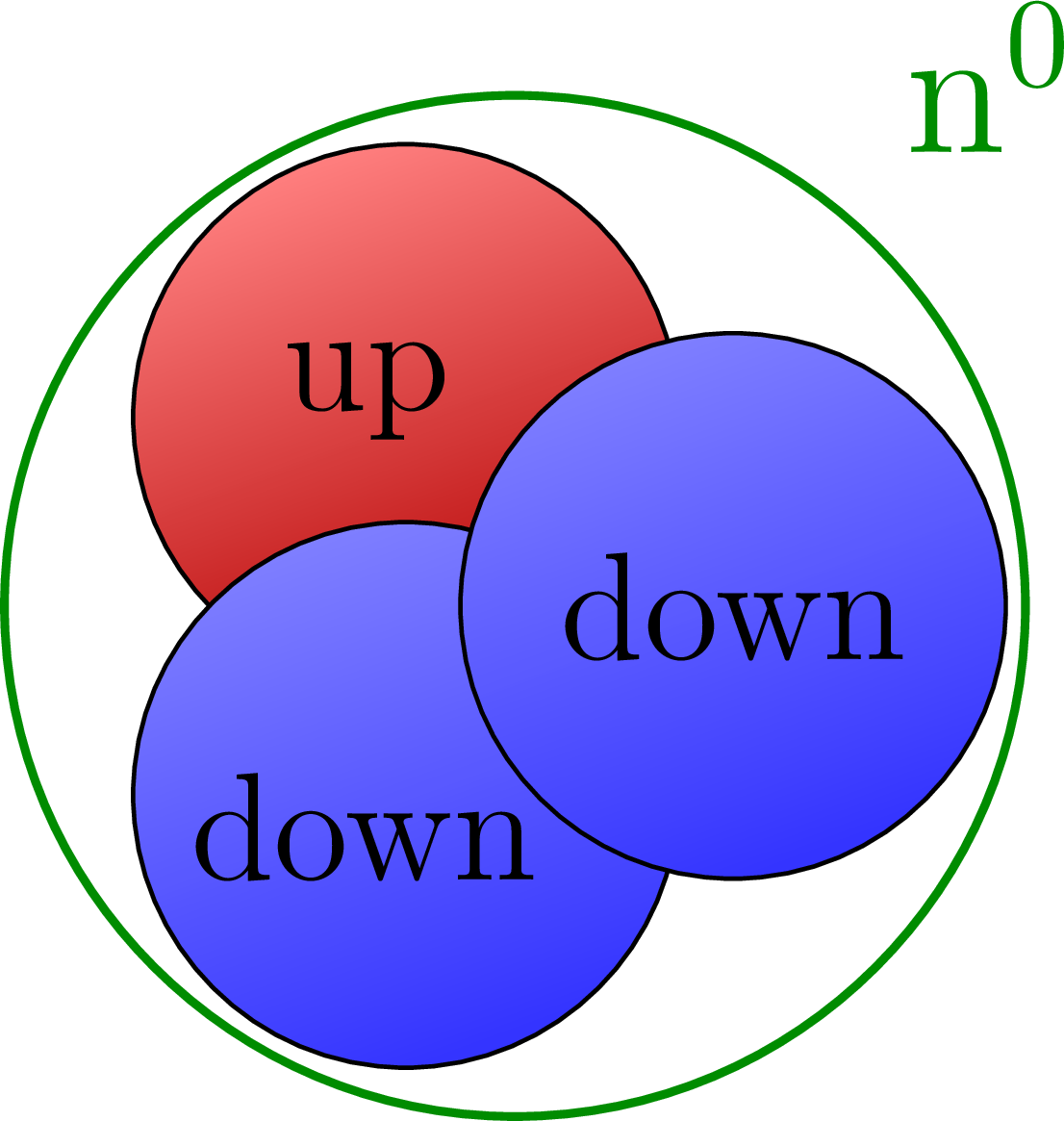
Hypothetical composite model of the tau lepton:
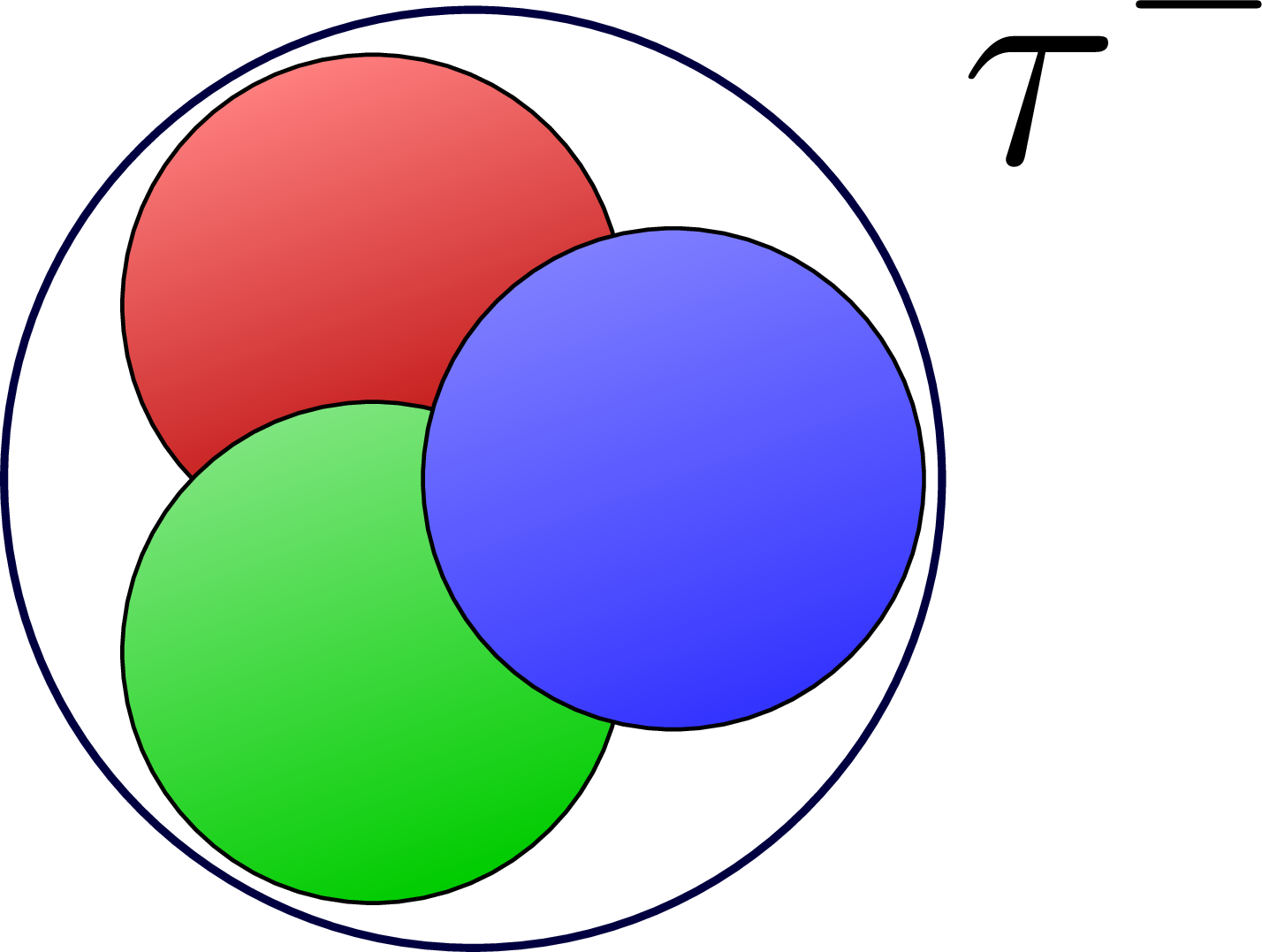
Populair depiction of an atom model:
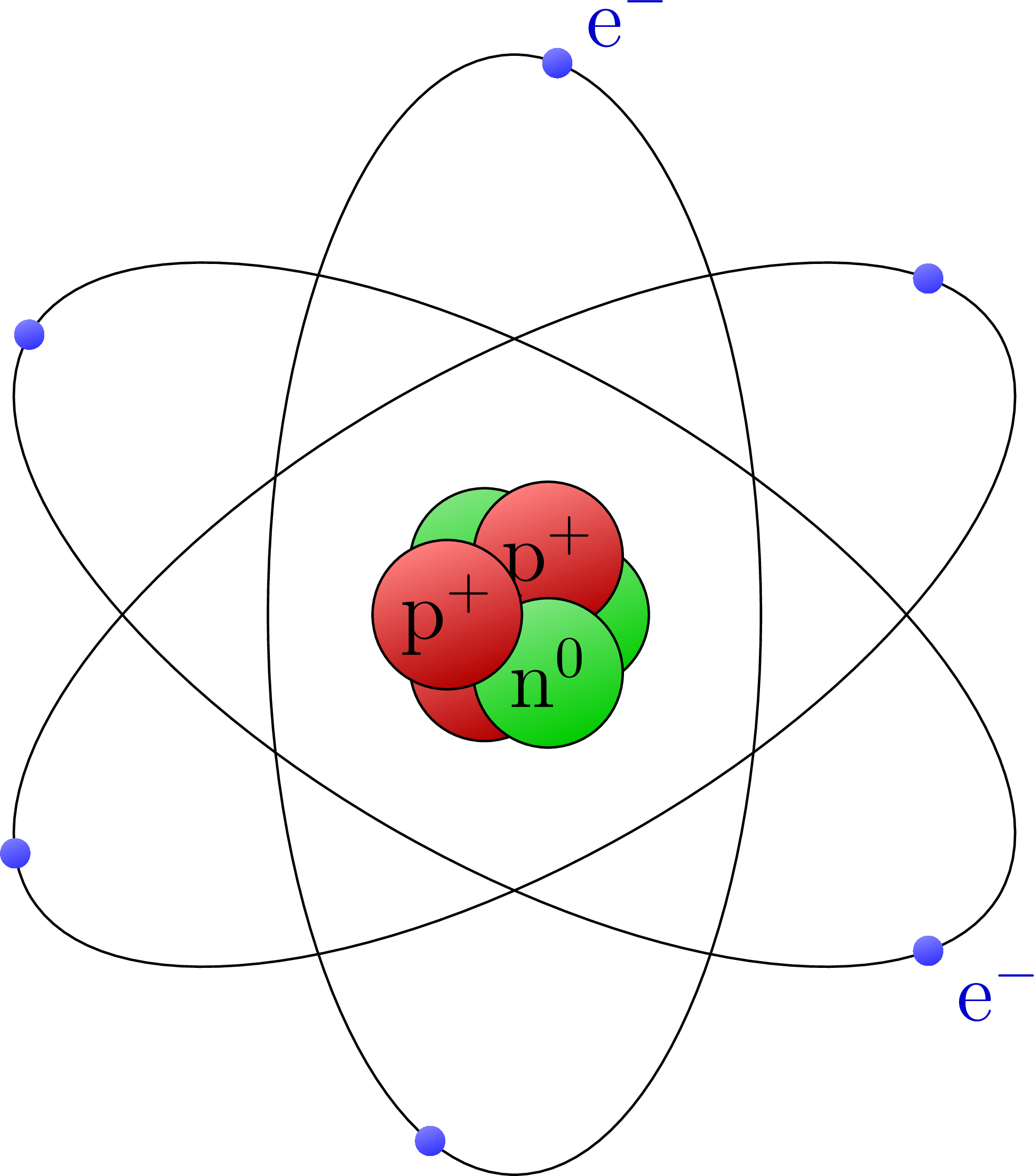
Free-electron model of a metal to explain electric conduction:
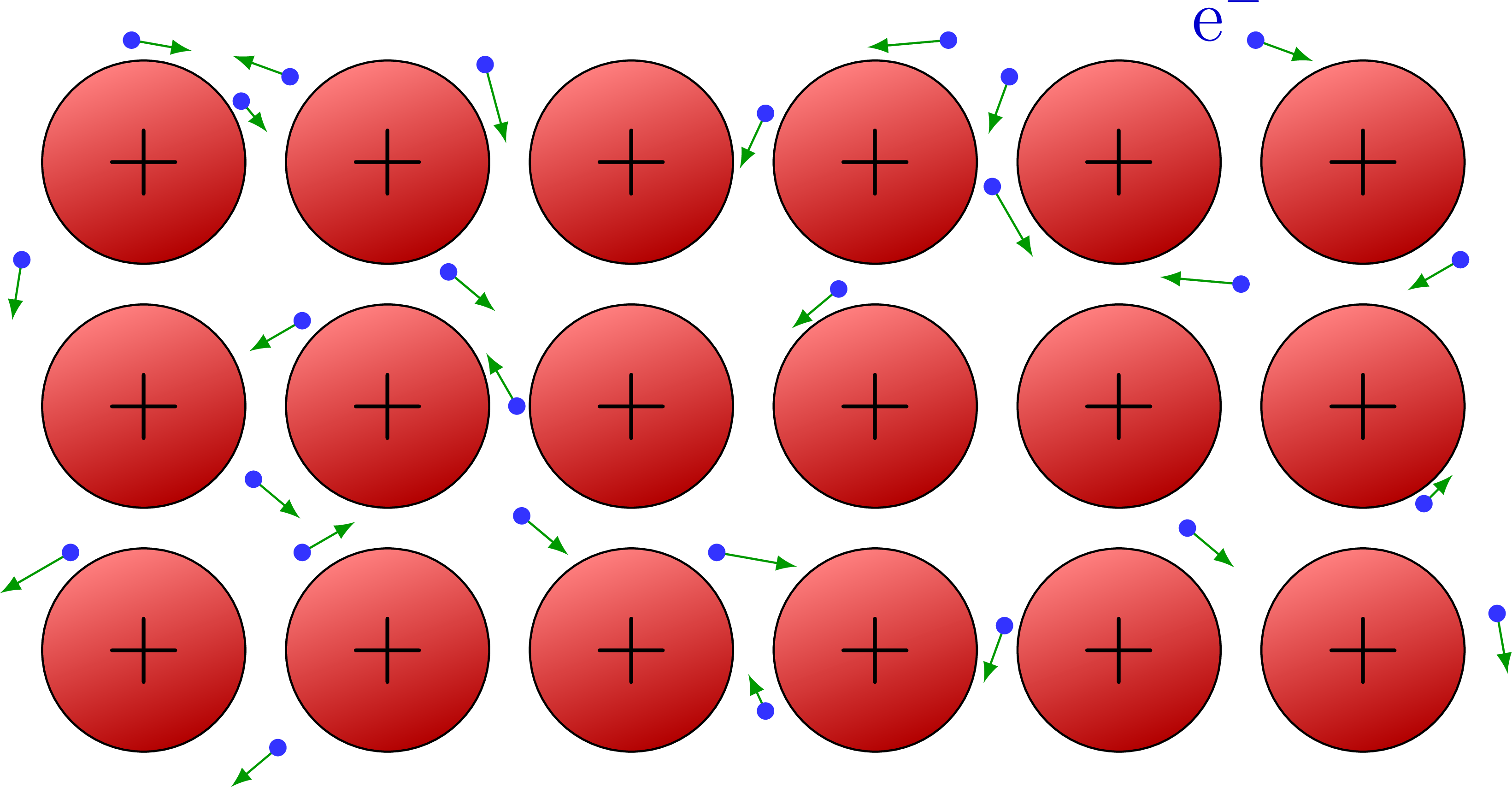
Bohr model of a copper atom with an valence electron:
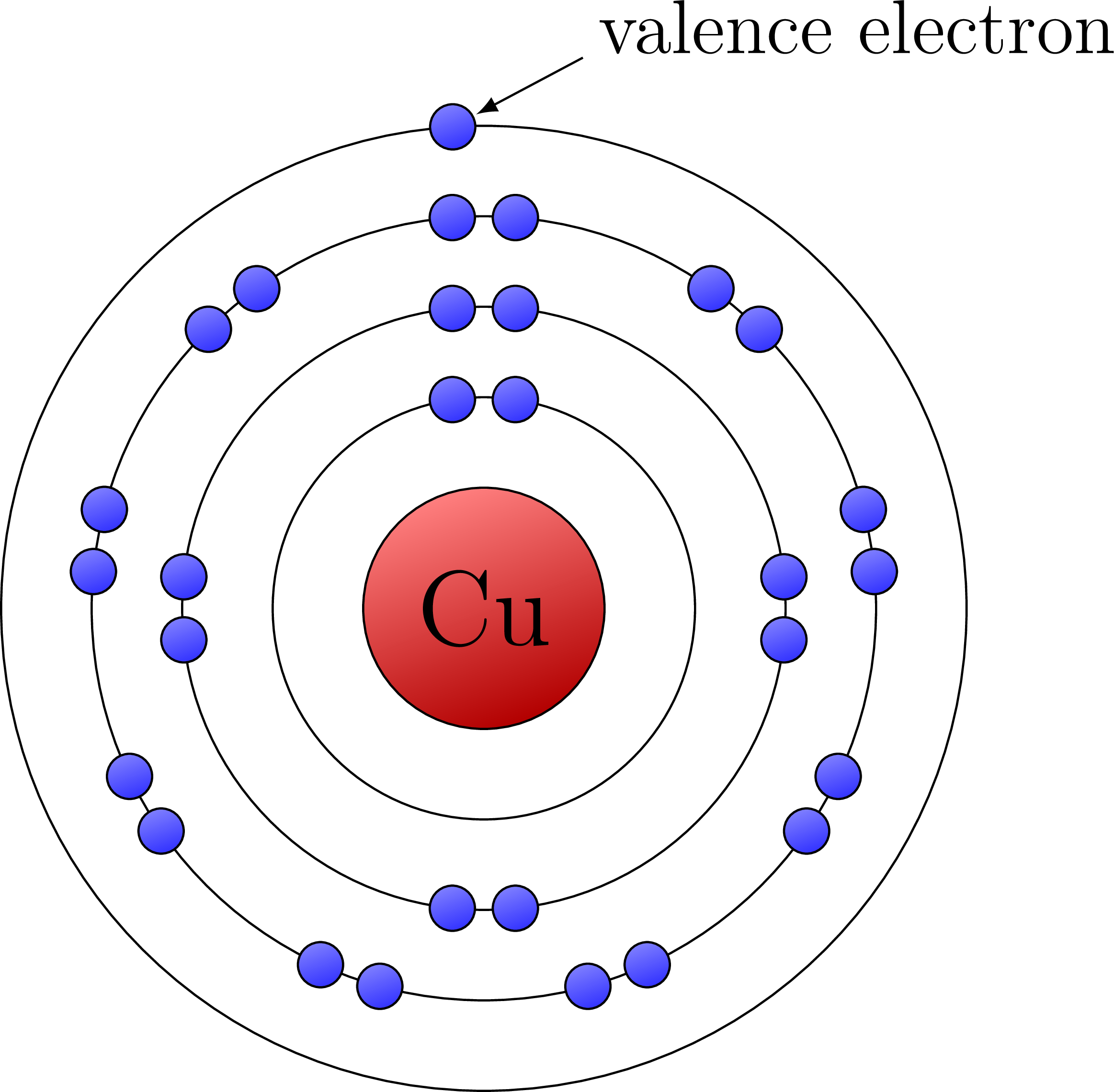
Edit and compile if you like:
% Author: Izaak Neutelings (July 2018)
\documentclass[border=3pt,tikz]{standalone}
\usepackage{amsmath}
\usepackage{tikz}
\tikzset{>=latex} % for LaTeX arrow head
%\usepackage{xcolor}
%\colorlet{charge+}{blue!80!white}
\tikzstyle{charge0}=[top color=green!80!black!50,bottom color=green!80!black,shading angle=20]
\tikzstyle{charge+}=[top color=red!50,bottom color=red!70!black,shading angle=20]
\tikzstyle{charge-}=[top color=blue!50,bottom color=blue!80,shading angle=20]
%\tikzstyle{charge+}=[thin,ball color=blue!60,shading angle=-10]
%\tikzstyle{charge-}=[thin,ball color=red!85,shading angle=-10]
%\tikzstyle{charge0}=[thin,ball color=green!80!black!80,shading angle=-10]
\def\d{0.8}
\def\R{1.0}
\def\N{{1.04*(\R+\d)}}
\begin{document}
\Large
% PROTON MODEL
\begin{tikzpicture}[scale=0.9]
\coordinate (O) at ( 0, 0);
\coordinate (D1) at ( 0:\d);
\coordinate (U1) at (120:\d);
\coordinate (U2) at (240:\d);
\coordinate (L) at ( 50:\N);
\draw[charge+] (U1) circle (\R) node[above=2,above left=-9] {up};
\draw[charge+] (U2) circle (\R) node[below=2,below left=-9] {up};
\draw[charge-] (D1) circle (\R) node {down};
\draw[thick,red!45!black] (O) circle (\N);
\node[above right=-4,scale=1.2,red!45!black] at (L) {$\text{p}^+$};
\end{tikzpicture}
% NEUTRON MODEL
\begin{tikzpicture}[scale=0.9]
\coordinate (O) at ( 0, 0);
\coordinate (D1) at ( 0:\d);
\coordinate (D2) at (240:\d);
\coordinate (U1) at (120:\d);
\coordinate (L) at ( 50:\N);
\draw[charge+] (U1) circle (\R) node[above=2,above left=-9] {up};
\draw[charge-] (D2) circle (\R) node[left=4,below=-7] {down};
\draw[charge-] (D1) circle (\R) node {down};
\draw[thick,green!55!black] (O) circle (\N);
\node[above right,scale=1.2,green!55!black] at (L) {$\text{n}^0$};
\end{tikzpicture}
% ATOM MODEL
\begin{tikzpicture}[scale=0.45]
\def\a{3.3}
\def\b{7.5}
\def\d{0.8}
\def\D{0.9}
\def\e{0.2} % electron radius
\coordinate (O) at ( 0, 0);
\coordinate (N1) at ( 0:\d);
\coordinate (N2) at (120:\d);
\coordinate (N3) at (300:\D);
\coordinate (P1) at (240:\d);
\coordinate (P2) at ( 60:\D);
\coordinate (P3) at (180:\D);
% NUCLEUS
\draw[charge0] (N1) circle (\R);
\draw[charge0] (N2) circle (\R);
\draw[charge+] (P1) circle (\R);
\draw[charge+] (P2) circle (\R) node {$\text{p}^+$};
\draw[charge0] (N3) circle (\R) node {$\text{n}^0$};
\draw[charge+] (P3) circle (\R) node {$\text{p}^+$};
% ELECTRONS
\draw[rotate= 0] (0,0) ellipse ({\a} and {\b});
\draw[rotate=120] (0,0) ellipse ({\a} and {\b});
\draw[rotate=240] (0,0) ellipse ({\a} and {\b});
\foreach \i/\ellipse/\theta [evaluate={\x=\a*cos(\theta-\ellipse); \y=\b*sin(\theta-\ellipse);}]
in {1/0/80,2/0/250,3/120/50,4/120/200,5/240/150,6/240/-50}{
\fill[charge-,rotate=\ellipse] (\x,\y) circle (\e) coordinate (E\i); %node[above right] {$\text{e}^-$};
}
\node[below=2,above right,blue!80!black] at (E1) {$\text{e}^-$};
\node[below=-4,below right,blue!80!black] at (E6) {$\text{e}^-$};
\end{tikzpicture}
% CONDUCTION MODEL
\begin{tikzpicture}[
scale=1.4,
%electron/.pic={
% \tikzset{/electron/.cd,#1}
% \draw[->,green!60!black] (0,0) -- (\vec);
% \node[circle,fill,inner sep=1.2,fill=blue!80] at (0,0,0) {};
%}
%/electron/.search also={/tikz},
%/electron/.cd,
%vec/.store in=\vec, vec={90:0.2}
%% use as \pic at (0.20,0.90) {electron={vec={210:0.4}}};
]
\def\R{0.5}
\def\a{1.2}
\def\Nx{6}
\def\Ny{3}
\def\electron#1#2#3{
\draw[->,green!60!black] (#1*\a,#2*\a) --++ (#3);
\node[circle,fill,inner sep=1.2,fill=blue!80] at (#1*\a,#2*\a) {};
}
% IONS
\foreach \j in {1,...,\Ny}{ %[evaluate={\y=\j*\a;}]
\foreach \i in {1,...,\Nx}{ %[evaluate={\x=\j*\a;}]
\draw[charge+] ({(\i-0.5)*\a},{(\j-0.5)*\a}) circle (\R) node[scale=1.4] {$+$};
}
}
%%%%%%%%%%%%%%%%%%%%%%%%%%%%%%% 0
\electron{0.20}{0.90}{ 210:0.4}
\electron{0.00}{2.10}{ -99:0.3}
\electron{0.45}{3.00}{ -10:0.3}
%%%%%%%%%%%%%%%%%%%%%%%%%%%%%%% 1
\electron{1.05}{0.10}{-140:0.3}
\electron{0.95}{1.20}{ -40:0.3}
\electron{1.15}{0.90}{ 30:0.3}
\electron{1.15}{1.85}{ 210:0.3}
\electron{0.90}{2.75}{ -50:0.2}
\electron{1.10}{2.85}{ 160:0.3}
%%%%%%%%%%%%%%%%%%%%%%%%%%%%%%% 2
\electron{2.05}{1.05}{ -40:0.3}
\electron{2.03}{1.50}{ 120:0.3}
\electron{1.75}{2.05}{ -40:0.3}
\electron{1.90}{2.90}{ -75:0.4}
%%%%%%%%%%%%%%%%%%%%%%%%%%%%%%% 3
\electron{3.05}{0.25}{ 115:0.2}
\electron{2.85}{0.90}{ -10:0.4}
\electron{3.35}{1.98}{-140:0.3}
\electron{3.05}{2.70}{-115:0.3}
%%%%%%%%%%%%%%%%%%%%%%%%%%%%%%% 4
\electron{4.03}{0.60}{-110:0.3}
\electron{3.98}{2.40}{ -60:0.4}
\electron{3.80}{3.00}{ 185:0.4}
\electron{4.05}{2.85}{-110:0.3}
%%%%%%%%%%%%%%%%%%%%%%%%%%%%%%% 5
\electron{4.78}{1.00}{ -40:0.3}
\electron{5.00}{2.00}{ 175:0.4}
\electron{5.06}{3.00}{ -20:0.3}
%%%%%%%%%%%%%%%%%%%%%%%%%%%%%%% 6
\electron{6.05}{0.65}{ -80:0.3}
\electron{5.75}{1.10}{ 45:0.2}
\electron{5.90}{2.10}{-150:0.3}
%%%%%%%%%%%%%%%%%%%%%%%%%%%%%%%
\node[above left=-5,blue!80!black] at (5.1*\a,3.0*\a) {$\mathrm{e}^-$};
\end{tikzpicture}
% CUPPER ATOM
\begin{tikzpicture}
\def\R{0.8}
\def\a{0.6}
\def\re{0.15}
\def\dang{12}
% NUCLEUS
\draw[charge+] (0,0) circle (\R) node[scale=1.4] {Cu};
% ORBITAL
\foreach \i/\No [evaluate={\r=\R+\i*\a;}] in {1/1,2/4,3/9}{
\draw (0,0) circle (\r);
\foreach \j [evaluate={\ang=90+\j*360/\No;}] in {1,...,\No}{
\draw[charge-] ( \dang/\r+\ang:\r) circle (\re);
\draw[charge-] (-\dang/\r+\ang:\r) circle (\re);
}
}
% VALENCE ELECTRON
\draw (0,0) circle (\R+4*\a);
\draw[charge-] (93.7:\R+4*\a) circle (\re) coordinate (V);
\draw[<-] (V) ++ (28:1.18*\re) --++ (28:0.8) node[below=2,above right=-2] {valence electron};
\end{tikzpicture}
% COMPOSITE MODEL
\begin{tikzpicture}[scale=0.9]
\coordinate (O) at ( 0, 0);
\coordinate (D1) at ( 0:\d);
\coordinate (U1) at (120:\d);
\coordinate (U2) at (240:\d);
\coordinate (L) at ( 30:\N);
\draw[charge+] (U1) circle (\R);
\draw[charge0] (U2) circle (\R);
\draw[charge-] (D1) circle (\R);
\draw[thick,blue!25!black] (O) circle (\N);
\node[above right=-2,scale=2.1] at (L) {$\tau^-$};
\end{tikzpicture}
\end{document}Click to download: charged_particles.tex • charged_particles.pdf
Open in Overleaf: charged_particles.tex
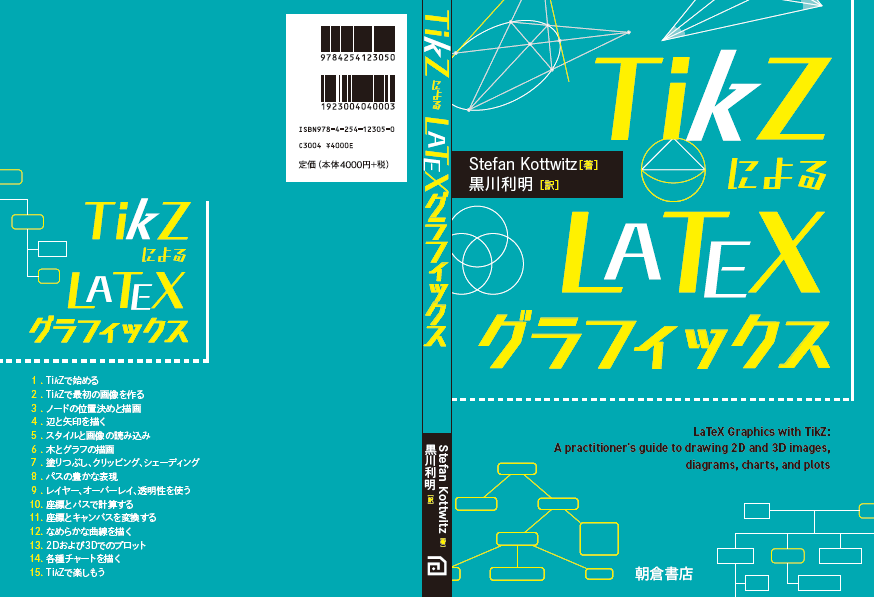
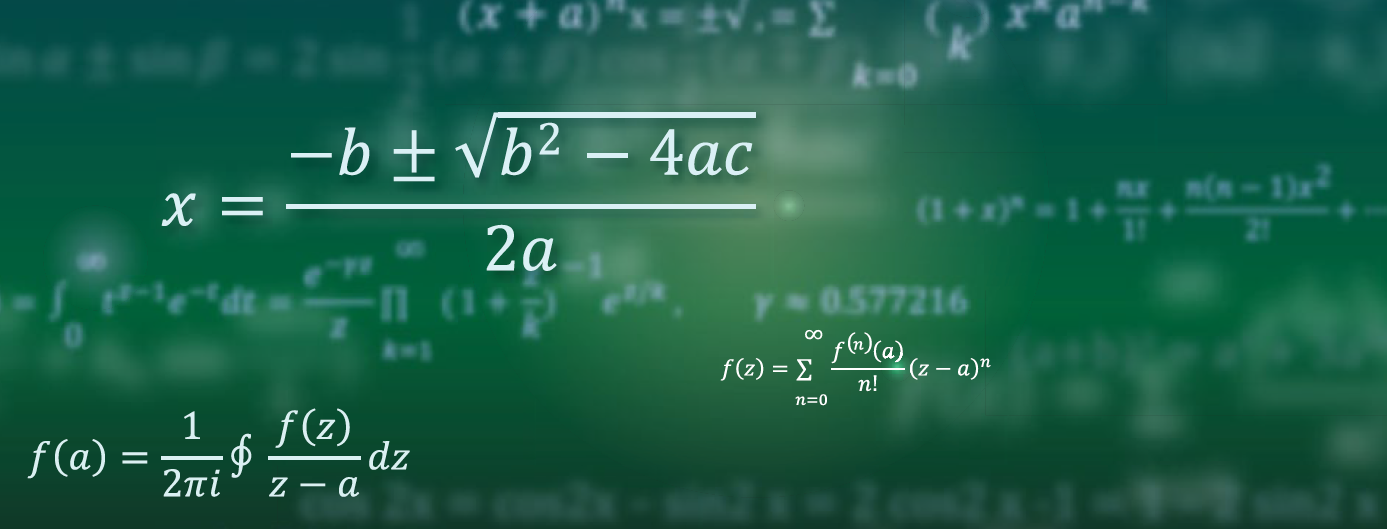

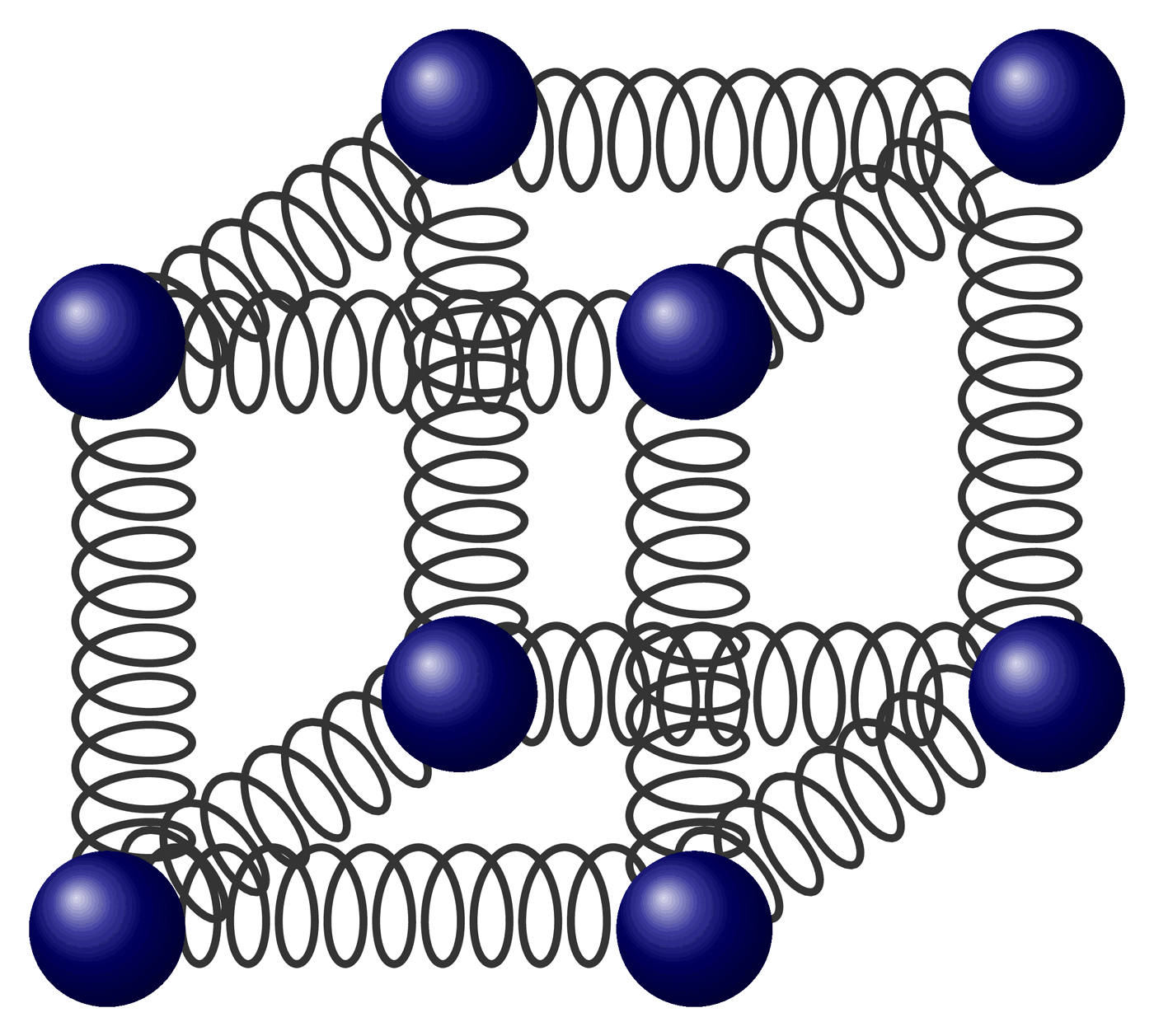
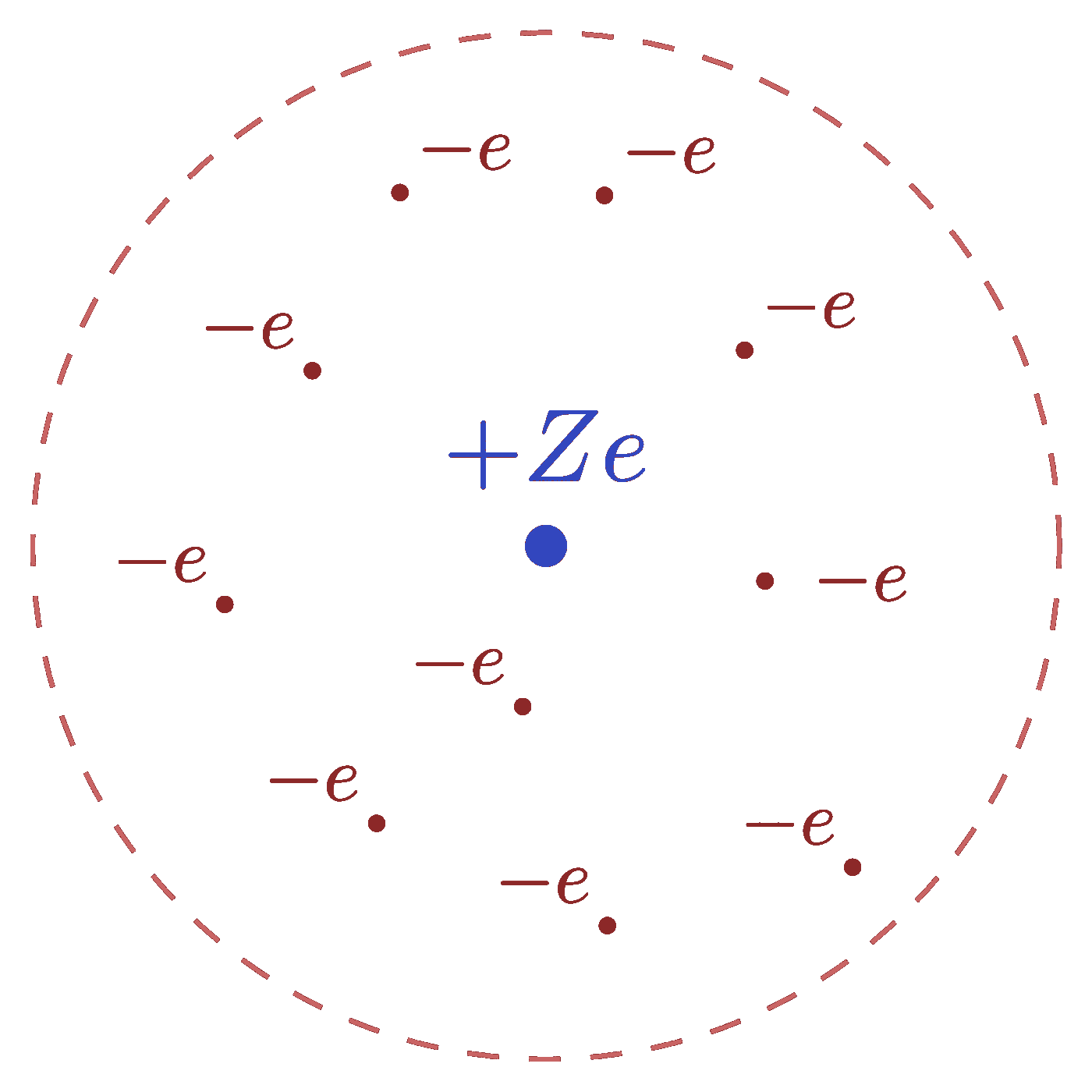
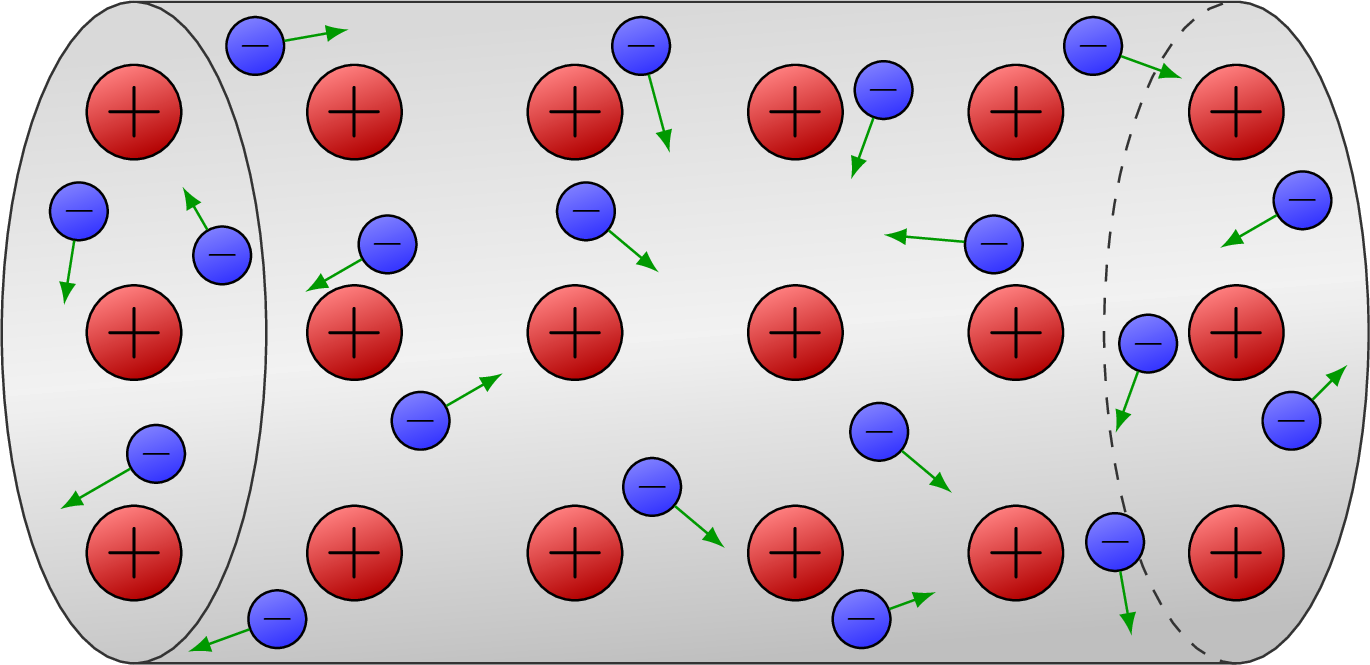
Hello!
I used your conduction model to represent conduction (of course!)
I am teaching thermal processes to my class, so I wrote this simple code (to the best of my abilities so far) to represent convection
\documentclass{standalone}
\usepackage{tikz}
\usetikzlibrary{arrows.meta}
\begin{document}
\begin{tikzpicture}[>=Stealth, thick]
% Flat surface
\draw (0,0) — (6,0);
\draw[densely dashed] (0,0.2) — (6,0.2); % indicating surface
% Heat arrow
\draw[->, red] (3,-1) — (3,-0.2) node[midway, right] {Heat};
% Convection arrows
\draw[->, red] (1,0.5) to[out=0,in=-60] (2.75,2.5);
\draw[->, red] (5,0.5) to[out=180,in=-120] (3.25,2.5);
\draw[->, blue] (2,3) to[out=180,in=-240] (0,1);
\draw[->, blue] (4,3) to[out=0,in=-300] (6,1);
% Labels
\node at (3,-1.2) {\tiny Heat Source};
\node at (1.5,1.7) {\tiny Convection Current};
%\node at (4.5,1.7) {Convection};
\end{tikzpicture}
\end{document}
Can you see it as representing convection? How could I change it to make it better, more representative?
Thank you
Wagner.
Hi Wagner,
I would just add a volume of water with a red to blue fade, something like this:
\documentclass[border=3pt,tikz]{standalone} \usetikzlibrary{arrows.meta} \begin{document} \begin{tikzpicture}[>=Stealth, thick] % Volume \fill[bottom color=red!40,top color=blue!50!cyan!30,middle color=blue!50!cyan!20] (0,0) rectangle (6,3); % Flat surface \draw (0,0) -- (6,0); \draw[densely dashed] (0,0.2) -- (6,0.2); % indicating surface % Heat arrow \draw[->, red] (3,-1) -- (3,-0.2) node[midway, right] {Heat}; % Convection arrows \draw[->, red] (1,0.5) to[out=0,in=-60] (2.75,2.5); \draw[->, red] (5,0.5) to[out=180,in=-120] (3.25,2.5); \draw[->, blue] (2,3) to[out=180,in=-240] (0,1); \draw[->, blue] (4,3) to[out=0,in=-300] (6,1); % Labels \node at (3,-1.2) {\tiny Heat Source}; \node at (1.5,1.7) {\tiny Convection Current}; %\node at (4.5,1.7) {Convection}; \end{tikzpicture} \end{document}You could add more red color to indicate the heating along the bottom, and perhaps try to make it a bit more 3D with ellipses. You can look for inspiration on google image search.
For now, this will have to do… hehe! I teach this today, so this diagram will pass as convection. I divided the rectangle into 2 and did angled shading along the diagonal, so that it gives the very primitive impression that hot air is rising.
I will try to see if I can make hot air curve and protrude into the cold air at the top and the cold air into the hot air at the bottom, so it gives a more realistic convection current.
I am trying to rewrite all my lessons in beamer… maybe that was a very stupid idea!
\documentclass[border=3pt,tikz]{standalone}
\usetikzlibrary{arrows.meta}
\begin{document}
\begin{tikzpicture}[>=Stealth, thick]
% Volume
\fill[bottom color=red!40,top color=blue!50!cyan!30,middle color=blue!50!cyan!20,shading angle=45]
(0,0) rectangle (3,3.5);
\fill[bottom color=red!40,top color=blue!50!cyan!30,middle color=blue!50!cyan!20,shading angle=315]
(3,0) rectangle (6,3.5);
% Flat surface
\draw (0,0) — (6,0);
\draw[densely dashed] (0,0.2) — (6,0.2); % indicating surface
% Heat arrow
\draw[->, red] (3,-1) — (3,-0.2) node[midway, right] {Heat};
% Convection arrows
\draw[->, red] (1,0.5) to[out=0,in=-60] (2.75,2.5);
\draw[->, red] (5,0.5) to[out=180,in=-120] (3.25,2.5);
\draw[->, blue] (2,3) to[out=180,in=-240] (0.5,1);
\draw[->, blue] (4,3) to[out=0,in=-300] (5.5,1);
% Labels
\node at (3,-1.2) {\tiny Heat Source};
\node at (1.5,1.7) {\tiny Convection Current};
%\node at (4.5,1.7) {Convection};
\end{tikzpicture}
\end{document}
Maybe something like this?
\documentclass[border=3pt,tikz]{standalone} \usetikzlibrary{arrows.meta} \usetikzlibrary{fadings} \begin{tikzfadingfrompicture}[name=halo] \shade[inner color=transparent!0,outer color=transparent!100] (0,0) circle (0.8); \end{tikzfadingfrompicture} \begin{document} \begin{tikzpicture}[>=Stealth, thick] % Volume \begin{scope} \clip (0,0) rectangle (6,3.5); \fill[blue!50!cyan!30] (0,0) rectangle (6,3.5); \fill[path fading=halo,red!40] % halo/ (3,0) ellipse (3.6 and 3.5); %\fill[inner color=red!40,outer color=blue!50!cyan!30] % (3,0) circle(4.5); \end{scope} % Flat surface \draw (0,0) -- (6,0); \draw[densely dashed] (0,0.2) -- (6,0.2); % indicating surface % Heat arrow \draw[->, red] (3,-1) -- (3,-0.2) node[midway, right] {Heat}; % Convection arrows \draw[->, red] (1,0.5) to[out=0,in=-60] (2.75,2.5); \draw[->, red] (5,0.5) to[out=180,in=-120] (3.25,2.5); \draw[->, blue] (2,3) to[out=180,in=-240] (0.5,1); \draw[->, blue] (4,3) to[out=0,in=-300] (5.5,1); % Labels \node at (3,-1.2) {\tiny Heat Source}; \node at (1.5,1.7) {\tiny Convection Current}; %\node at (4.5,1.7) {Convection}; \end{tikzpicture} \end{document}Good luck with teaching!